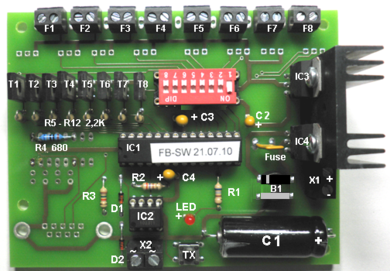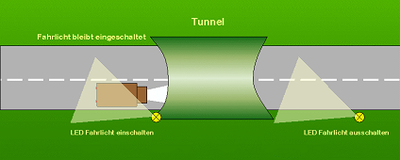Function module
Contents
- 1 Function module
- 2 Abstandssteuerung K (1+3)
- 3 Abstandssteuerung L (1+4)
- 4 Geschwindigkeiten M(1+5)
- 5 Parken N (1+6)
- 6 Anhänger 1 O(1+7)
- 7 Anhänger 2 P(1+8)
- 8 Geschwindigkeit + Blinker Q (2+3)
- 9 Halt auf Zeit R(Schalter 2+4)
- 10 Blaulichter und Abstandssteuerung S(Schalter 2+5)
- 11 Lichter und Blaulichter T(Schalter 2+6)
- 12 Busautomatik Plus U(Schalter 2+7)
- 13 Automatiksteuerung 11.20 (Schalter 2+8)
- 14 Spurkontrolle(Schalter 3+4)
- 15 Lichter An(Schalter 3+5)
- 16 Sonderfunktionen(Schalter 3+6)
- 17 Sonderfunktionen (Schalter 3+7)
- 18 Rückwärtsfahrt (3+8)
- 19 Bushaltestelle (Schalter 3)
- 20 IR-LED on/in the street
- 21 Remote control
- 22 Function decoder
Function module
General
A function module transmits commands to a DC-Car decoder by means of a short range IR communication (10-20cm).
There are always 8 outputs available.
By using a dip switch 11 different module types are available
Supply voltage can be 12V - 16V AC or 12 - 16V DC
The outputs offer a current of 1A
By using a diode-circuit with 1N400x diodes it is possible to transmit multiple commands on one IR LED.
Stop module (All switches ON)
All switches ON Stop module means all 8 outputs sending a stop signal
Function Module A
Basic Commands
Dipswitch 1 must be set ON
1 = Speed at speed step 0 (stop)
2 = headlights 1 ON
3 = headlights 1 OFF
4 = Left indicator ON
5 = Right indicator ON
6 = Indicators OFF
7 = Speed at speed step 14
8 = Speed at speed step 28
Function Module B
Flashing Blue light vehicles
Dipswitch 2 must be set ON
1 = Speed at speed step 0 (stop)
2 = Hazard lights on
3 = Hazard kights OFF
4 = Flashing blue-light ON
5 = Flashing blue-light OFF
6 = Front-flasher ON
7 = Front-flasher OFF
8 = Speed at speed step 28
Function Module C
Additional lights and speed
Dipswitch 3 must be set ON
1 = Light 2 ON
2 = Light 2 OFF
3 = Light 3 ON
4 = Light 3 OFF
5 = Speed + 2 steps (accelerate)
6 = Speed - 2 steps (slowdown)
7 = Speed at speed step 10
8 = Speed at speed step 21
Function Module D
Automatic parking
Dip switch 4 must be set ON
(Stop time adjustable with CV108)
1 = Stop without direction indicators
2 = Stop with direction indicators on the left
3 = Stop with direction indicators on the right
4 = Stop with hazard lights
Drive off with driving position as specified in CV110 (flashing time adjustable with CV109)
5 = Driving / accelerating without direction indicators
6 = Drive / accelerate with direction indicators on the left
7 = Drive / accelerate with direction indicators on the right
8 = Driving / accelerating with hazard lights
Function Module E
Bus automatic
Dip switch 5 must be set ON
Commands E2 - E7 are only executed by vehicles that have
been configured as vehicle types 13, 14 or 15 in CV100!
1 = Speed at speed step 0 (Stop)
2 = Bus stop, direction indicators OFF, interior lighting OFF
3 = Bus stop, direction indicators OFF, interior lighting ON
4 = Bus stop, direction indicators right, interior lighting ON
5 = Bus stop, alarm light ON, interior lighting ON
(Flashing time adjustable in CV106)
6 = Bus leaves with speed step as set in CV105 and direction indicators left
7 = Arrival at the bus stop with speed step as set in CV102 and
direction indicators right (flashing time adjustable in CV101)
8 = Speed at speed step 0 (Stop)
Function Module F
Technic
Dip switch 6 on ON
1 = Switch OFF sensors front (FTR)
2 = Switch ON sensors front (FTR)
3 = Switch OFF reed contact
4 = Switch ON reed contact
5 = Switch OFF the light sensor
6 = Switch ON the light sensor
7 = Switch OFF rear IR LEDs
8 = Switch ON rear IR LEDs
Function Module G
Emergency vehicles
Dip switch 7 must be set ON
1 = Speed at speed step 0 (Stop)
2 = Rotating beacons and front flashers ON
3 = Rotating beacons and front flashers OFF
4 = Direction indicators left ON
5 = Direction indicators right ON
6 = Direction indicators OFF
7 = Speed in speed step 14
8 = Speed in speed step 28
Function Module H
Standard mix
Dipswitch 8 must be set ON
1 = Speed at speed step 0 (Stop)
2 = Light 1, direction indicators, flashing lights and front flasher OFF
3 = Light 1 ON
4 = Direction indicators left ON
5 = Direction indicators right ON
6 = Rotating beacons and front flashers ON
7 = Speed at speed step 14
8 = Speed at speed step 28
Function Module I
Remote control
All switches must be set OFF
1 = Time-controlled stop (programmed via CV108) direction indicator OFF
2 = Drive/accelerate after stop (time is out) with speed step from
CV110 (z.B. 1) direction indicator OFF
3 = Speed +2 (accelerate CV 98)
4 = All lights OFF
5 = Direction indicator left (with CV27=64 direction indicator
right + left (same time) = hazard lights possible)
6 = Direction indicator right (with CV27=64 direction
indicator right + left (same time) = hazard lights possible)
7 = Head light 1 (with CV60 light 1, 2, 3 and 4 at the same time possible)
8 = Beacon lights and front flashers with siren
(alternative: switch to continuous light for another two lights)
Function Module J
MF3, MF4 and MF5 functions(from 8.2016)
Dip switch 1 + 2 must be set ON
1 = Multi-function output (MF3) ON
2 = Multi-function output (MF3) OFF
3 = Multi-function output (MF4) ON
4 = Multi-function output (MF4) OFF
5 = Multi-function output (MF5) ON
6 = Multi-function output (MF5) OFF
7 = Speed at speed step 0 (Stop)
8 = Speed at speed step 0 (Stop)
Abstandssteuerung K (1+3)(Schalter 1+3)
Ab FUSW Firmware 1. März 2020 |
Abstandssteuerung L (1+4)(Schalter 1+4)
Ab FUSW Firmware 1. März 2020 |
Geschwindigkeiten M(1+5)(Schalter 1+5)
Ab FUSW Firmware 1. März 2020 |
Parken N (1+6)(Schalter 1+6)
Ab FUSW Firmware 1. März 2020 |
Anhänger 1 O(1+7)(Schalter 1+7)
Ab FUSW Firmware 1. März 2020 |
Anhänger 2 P(1+8)(Schalter 1+8)
Ab FUSW Firmware 1. März 2020 |
Geschwindigkeit + Blinker Q (2+3)(Schalter 2+3) Ab FUSW Firmware 29. April 2020 |
Halt auf Zeit R(Schalter 2+4)(Schalter 2+4) Ab FUSW Firmware 29. April 2020 |
Blaulichter und Abstandssteuerung S(Schalter 2+5)Einsatzfahrzeuge Anschluss = Befehl |
Lichter und Blaulichter T(Schalter 2+6)Einsatzfahrzeuge Anschluss = Befehl |
Busautomatik Plus U(Schalter 2+7)Busautomatik Anschluss = Befehl |
Automatiksteuerung 11.20 (Schalter 2+8)Fahrzeugdecoedr ab Nov 2020 |
Spurkontrolle(Schalter 3+4)ab Juni 2023 |
Lichter An(Schalter 3+5)ab 15. Aug 21 |
Sonderfunktionen(Schalter 3+6)ab MRZ 2023 |
Sonderfunktionen (Schalter 3+7)ab 1.12.21 |
Rückwärtsfahrt (3+8)ab Mrz 2023 |
Bushaltestelle (Schalter 3)nur 25.11.22 Sonderfall |
IR-LED on/in the street
Mounting of the IR-LED on the site:
The IR-LED is placed in or nearby the street in such a way that the cars can "see" the IR-light, emitted by the LED and execute the transmitted function at the intended place.
The IR-LED must be adjusted in a way, that the approaching vehicles can "see" it. On a straight line the vehicles detect the desired function in a distance of approx. 5 - 15cm from the LED
Sometimes a IR-LED influences the traffic on a parallel line too. In this case you can either increase the series resistor to decrease the range of the IR-signal or mount the LED into the street in a way that its IR beam lights vertical only.
If you do the second, please use LED with a wider angle of reflection.
Distance of the LEDs shoul be 5 - 10cm, but it is highly recommended to test it in every single case!
When the car passes the first LED it will start slowing down - an when it reaches the second LED in most cases it is that slow,
that it can come to a stop right there.
Using cars with a significiant lag it can be neccessary to use more LEDs
The LEDs are connected to the same connector, each ussing its own series resistor.
Remote control
Instead of function module I:
To make it easy for you we produce a battery powered remote control: MF plus.
The Plus version has build in test functions which can be used with the optional test set. These test functions have proved to be very usefull when building vehicles.
You can test polarity and working of LEDs as well measuring short circuits.
With the foto transistor (include in the set) your able to check the working of the IR LEDs at the back of the vehicles as well IR signals along the road.
And with the remote control it self your able to test the fototransistors at the front and the correct operation of the decoder and vehicle.
Function decoder
Using the function module in DCC mode with a digital center
A function module can be extended with a digital input. After extension the function module becomes a function decoder.
This enables switching the 8 outputs from a digital center using the addresses 1-8, (9-15), etc.
Note: All LEDs on each output are switched ON or OFF together!
Especially in combination with other functions, like switching the light output makes sense.
The decoder can be used in the same way as the module, but offers the possibility to switch the 8 outputs separately by means of 8 digital addresses.
- central switching of "stop" for emergency OFF
- central switching of light for day-/night mode
Direction indicators are controlled by feedback sensors of junctions, lights are controlled by a digital addresses
Day/night control with a function decoder other functions still can be controlled by switches

